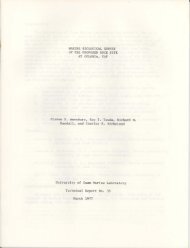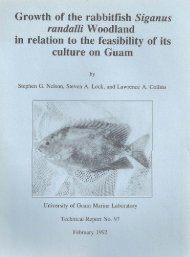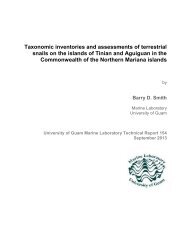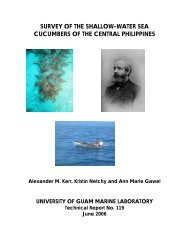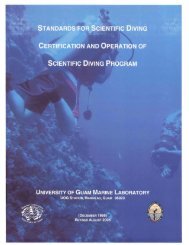Marine Protected Area Surveys Central Visayas, Philippines 2007
Marine Protected Area Surveys Central Visayas, Philippines 2007
Marine Protected Area Surveys Central Visayas, Philippines 2007
Create successful ePaper yourself
Turn your PDF publications into a flip-book with our unique Google optimized e-Paper software.
Raymundo and Maypa 2008 UOG Tech. Rep. 122<br />
difference between the MPA and the fishing grounds. However, several of the fishing ground<br />
values are lower than that of the MPA, reflecting the effects of fishing. Individual sites are<br />
discussed below.<br />
Mean fish diversity/500m<br />
100.0<br />
90.0<br />
80.0<br />
70.0<br />
60.0<br />
50.0<br />
40.0<br />
30.0<br />
20.0<br />
10.0<br />
0.0<br />
Balicasag I.<br />
Tawala<br />
MPA<br />
Fished<br />
Bil-isan<br />
Gilutongan<br />
Talima<br />
Basdiot<br />
Saavedra<br />
Zaragosa<br />
Maayong Tubig<br />
Apo Is.<br />
Site<br />
Figure 6. Fish assemblage species diversity at 10 reefs, comparing<br />
<strong>Marine</strong> <strong>Protected</strong> <strong>Area</strong>s and adjacent fishing grounds. N=3 transects per<br />
site; Mean +/- SE.<br />
In Figure 7a, we present representative photographs of the six diseases and syndromes<br />
that we observed affecting our surveyed reefs. These diseases have all previously been<br />
described and identified from the <strong>Philippines</strong> (Raymundo et al. 2003; Kaczmarsky 2005;<br />
Raymundo et al. 2005). During this survey, we did not encounter any disease state not<br />
previously described, though prevalence of individual diseases changed slightly between 2006<br />
and <strong>2007</strong>. White Syndrome was the most common disease observed, followed by Ulcerative<br />
White Spot Disease and Skeletal Eroding Band. We observed no evidence of any disease<br />
outbreaks on any of our surveyed reefs, though several sites showed relatively high overall<br />
mean disease prevalence. Total disease prevalence (i.e., the percent of surveyed colonies<br />
affected by disease) ranged from a low of 1.7% (Maayong Tubig MPA) to a high of 8.4%<br />
(Basdiot fishing ground). In general, disease prevalence was lower within the MPAs and higher<br />
within the fishing grounds in paired sites. We discerned this pattern in the 2006 surveys, as<br />
well.<br />
Figure 7b presents some of the more common non-disease sources of stress or damage<br />
that corals experience in our reefs. It is important to note these as well, as they can represent a<br />
weakened coral; one that may be more susceptible to disease. Such observations can also<br />
9





